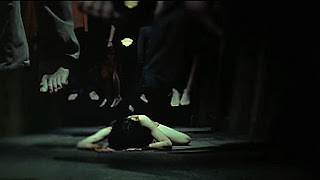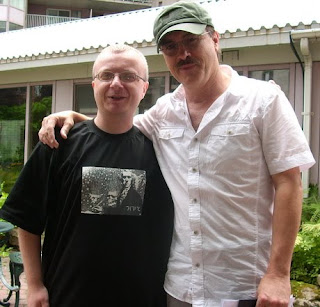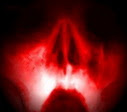
If you like horror in any shape or form, then you must've read one of the greatest, scariest and most intelligent SF-horror novels of the 20th century - AT THE MOUNTAINS OF MADNESS by H. P. Lovecraft.
And, if you like horror movies, then you probably know that Guillermo del Toro (HELLBOY) is set to direct a solid-budget version of AT THE MOUNTAINS OF MADNESS with James Cameron producing. The recent announcement that the long-gestating project will be financed by Cameron's AVATAR money was largely considered good news. With dozens of announced Del Toro projects in various stages, this development made it seem like this particular film is going to happen, after all. And reasonably soon, too.
Well, I managed to lay my tentacles on the screenplay for AT THE MOUNTAINS OF MADNESS, written by Guillermo Del Toro and Matthew Robbins, and here's what I thought of it.
Before you read it, just a brief note - as it turns out, the version of the script this review is based on is a slightly older one: there were three more drafts after this one. See the PS note at the bottom of this text.
Briefly: it feels like a HELLBOY movie without Hellboy, with a light dose of Carpenter's THE THING.
It's not as bleak as Lovecraft's novel or Carpenter's film which was vaguely inspired by the spirit of this same novel, although based on J. W. Campbell's novella. With the kind of budget this film will require one cannot reasonably expect it to go too far into the unconventional and risqué territory. I guess we should be content with the fact that this is most definitely a script for an R-rated monster-fest and there's no way of cutting it down to a PG-13 or some such shit without throwing more than a half away. However, with all the monster-mayhem, this still remains a Lovecraft-lite project.
There's plenty to like and a few things to dislike in this script.
AT THE MOUNTAINS OF MADNESS, as written by Del Toro and Robbins, is definitely aimed at those who "know" their Lovecraft from second- or third-hand: not directly from his stories, but from the way his work was re-imagined and grotesquely dumbed-down by the pop-culture. by this I mean his genre fiction "followers" (in name only, mostly), comics, video-games, RPG, heavy metal songs and the like. Those who perceive Lovecraft merely as an eccentric who wrote about some cool mega-monsters with lots of tentacles and slimy orifices are in for a treat here. Because that's ALL of Lovecraft they're gonna get. Those who expect a certain meaning and symbolism behind those "monsters" – those who expect philosophy – cosmic horror – loads of atmosphere, suspense, build-up... Well, not much of that, sadly.
It is a period piece: the frame story takes place in 1939, at the very beginning of World War 2 (quite unnecessary and silly parallel!), but the bulk of the film is made up of a flashback narration by the last survivor of the previous expedition to the South Pole from 1930. Of course, it is told to the chief of the new expedition going there… This being a classic, I guess there's no need for going too much into details, you know the plot. Scientists go to Antarctica, find remnants of primaeval, alien creatures, reveal terrible things about the (pre)human history. In this version, it si somewhat simplified into: Scientists go to Antarctica, resurrect primaeval monsters, mayhem ensues.
WHAT TO EXPECT?
1) More monsters, creatures, mutants, hybrids than in the entire Lovecraft's opus.

Just to make myself clear: I love me some cool movie monsters as any guy, and then some. Especially if those monsters are made-up of humans – men and women merging with things, or other creatures, human forms emerging from blobs of alien flesh with plenty of tentacles... ehhh, there's nothing out there in horror cinema to please me more. This script takes Lovecraft's concept of Shoggoths – large blobs of intelligent protoplasm which can assume any shape (including human) – and runs with it to lengths that Lovecraft never bothered with. In his novel, those creatures had a clever role in the complex history of the rise and fall of The Old Ones (basically, slaves rebelling and destroying their masters). In this film, they are a perfect alibi for countless scenes of cool monster action – those blobs swallowing, partly digesting and re-creating humans (and dogs) into shapes nature never intended. The bigger picture they belong to is paid just a brief lip service, in a couple of lines of dialogue you might just miss while checking your text messages.
Yes, there will be inevitable comparisons to THE THING: the magnitude of some shape-shifting scenes here definitely surpasses what Carpenter (and Rob Bottin) concocted; there are dog-things and dog-related action similar to THE THING as well; and some brief "is he human or Shoggoth?" doubts – though, what with all the stress on action, there's no time to lose on suspense, atmosphere, drama and stuff like that. Also, there is a much quicker and simpler test here, to see if one is a thing or human.
Like in THE THING, there are numerous characters in this script, briefly sketched, even more so here since there must be at least two dozen of them – plenty of food for Shoggoths, for sure, but only 3 or 4 of them really stand out as characters at all. The main guy, Dyer, is pretty lame, defined solely through the either/or dilemma: pregnant wife at home or scientific breakthrough at the South Pole. (Enter the moralizing tone, typical for Del Toro, and totally absent in Lovecraft – even more obvious in the character of an unscrupulous Doctor Lake, a comic-book Mad Scientist sacrificing everything and everyone to reach his goal. Damn those pulps!)
I never thought I could have too many creatures, but there's such an overload of them in this script that at some point they lose their entire scare factor and become just cool effects in broad snowy daylight – interesting images to enjoy while detachedly observing the fight of two-dimensional characters against them.
As for other thingees: The Old Ones have very little to do (except one human dissection which could be cool unless it's too brief to register); the albino penguins are slightly more prominent in this script than in the novel, but still remain mostly in the role of creepy bystanders; and, in case your monster-thirst remains insatiated, at the very end there is (yet another) appearance of Cthulhu itself! This last detail (if you can consider the mountain-sized monster – a detail!) is not only incongruous but downright stupid. Cthulhu is supposed to be "sleeping" in the deep warm waters of Pacific Ocean in his lair at R'Lyeh – not in the ice wastes of Antarctica!
No, this is not just some "geek" nit-picking: I'm all for artistic liberties and reimaginings (and there's plenty of those in this script – some of them fine), but bringing Cthulhu into this story out of nowhere makes absolutely no sense whatsoever within the film's own dumbed-down "mythology". It seems like an artificial, forced attempt at upping the ante and out-climaxing the climax – but, with no rhyme or reason. Hell, bring in Yog Sothoth and Shub Niggurath to the party, too. The more, the merrier! Or not?
Much as Lovecraft was accused of not knowing when to stop, his balanced, mostly restrained prose and well-thought narrative from his masterwork is used here as a starting point for a non-plus-ultra in monster-exaggeration with very little subtlety preserved. Lovecraft was forced to publish most of his works in pulp magazines, but his best work (such as AT THE MOUNTAINS OF MADNESS) is most definitely NOT pulp fiction. This script, in its essence, IS pulp – but big budget may hide this fact from many. And after decades of cheap direct to video in name only "adaptations" with shoddy effects and laughable dialogues – Del Toro's large-scale version will certainly be a step-up and a welcome improvement, at least in terms of visuals. Other than THE THING, FROM BEYOND, DEEP RISING and HELLBOY, few other films have even tried creatures this elaborate. That department certainly won't disappoint.
2) More action, action and action than in the entire Lovecraft's opus.
There are fights, flights, chases, shoot-outs, cliffhangers, last second salvations, big explosions... The pace is quick: once the action starts, around 30 minute mark, it never stops. NEVER. So, once this gets made and you go to the theater (as you should!), grab your popcorn in time and go to the bathroom BEFORE the film, because there's not a minute of non-action here to waste.
This approach is understandable in the light of bringing droves (and drones) of youthful audience into the theatre: Del Toro certainly doesn't want to bore them with some big thoughts or life-changing revelations. He's out there to entertain you with incredible creatures, action and 'splosions. Nothing wrong with that – unless you're one of a dozen remaining people on this planet who still believe that Lovecraft was about more, much more than that.
WHAT NOT TO EXPECT?
1) There's relatively little stress on atmosphere. OK, the Antarctica setting is spooky in itself, but it's mostly used as a background for chase and action scenes. Very little space for poetry and weird, alien beauty of the landscape. Hopefully they add some of that.
2) Don't expect a long and complex retelling of the history of the Old Ones – the bit that, according to many critics, is the key innovative element of Lovecraft's novel. It is the narrative which powerfully surpasses the pulpy Good/Evil dichotomies and presents a complex, clever and highly relevant account incomparable to genre fiction of its times – or to genre movies of our times, apparently. In this script, it is reduced to 3 or 4 sentences. I hope they make it a bit longer, and stress the human place in the entire story more convincingly and powerfully.
3) The section from the novel when the expedition goes deep, deep, insanely deep into the bowels of the Mountains of madness is entirely gone. Perhaps the scariest part of the book is gone completely. The submerged city in the deep caverns, too. None of that here. And very little exploring of the city above, as well. It seems like they discover the bas-reliefs with the Old Ones' history in the first building they come across, and that's it. I wanted to see more of the deserted city of the Old Ones!
4) Don't expect the same ending as in the novel. Expect a more predictable one.
To sum up: it all depends on your expectations. It'll definitely be an entertaining creature feature. The big budget will certainly buy some creative people to depict those cool monsters, and it will be a joy to see them on a big screen, in 3-D. I'll be there to see it the first chance I get, no doubt about it.
 If, on the other hand, you're not too happy with the idea of turning Lovecraft's far more complex (and scary!) novel into a rollercoaster monster romp, well, tough luck. You'll have to pray to Azathoth that this film earns enough money for a much belated resurrection of Lovecraft at the movies. With greater interest for his stuff among the movie audiences, who knows, maybe someone, some day, will conceive and produce a truly Lovecraftian film which will not be pulp – a film to capture Lovecraft's spirit, not just creatures? For now, we'll have to be content with those.
If, on the other hand, you're not too happy with the idea of turning Lovecraft's far more complex (and scary!) novel into a rollercoaster monster romp, well, tough luck. You'll have to pray to Azathoth that this film earns enough money for a much belated resurrection of Lovecraft at the movies. With greater interest for his stuff among the movie audiences, who knows, maybe someone, some day, will conceive and produce a truly Lovecraftian film which will not be pulp – a film to capture Lovecraft's spirit, not just creatures? For now, we'll have to be content with those.
PS: In the meantime, I got a message from someone close to the production in reaction to my review, and he said that the version I read & reviewed above is older, an that there are some (minor, I'd say) changes in the current version. Also, that the Thing appearing at the end is not really Cthulhu (as it was labelled in the version I read), but that it is some other, nameless 'deity'. This person also said that much of the detail remains VISUAL instead of TEXTUAL or dialogue oriented. What I called "poetry" and "atmosphere" is entirely dependant on execution, tempo and visual design, and thus not "scriptable". Or so they say.
Let's see.
With all possible pitfalls I mentioned (and some that I hadn't – like the WW2 allusions, which, for me, diminish the timeless horrors of Lovecraft to a historically superseded and all-too-human nazi horror), Del Toro's film is still the best chance Lovecraftian cinema has to break through from the confines of schlocky B-movies. With all due respect to Stuart Gordon, whom I interviewed a month ago at Fantasia (and whose work I more than respect and love!), I think Del Toro is the only real hope for truly Lovecraftian cinema at this moment, especially on this large scale. Well, maybe a mutant between Carpenter, Herzog and Lynch would do a better job at capturing the 'madness' part of these mountains, but as things stand, he's the one holding the torch. I can only pray that the production does not require too many compromises, and that they let him make an adequately dark and provoking vision of truly epic, alien terror.
PPS: A few more exclusive MADNESS pics, made in the John Hay Library at the Brown University, Providence, RI.
1. A certain Lovecraftian scholar poring over the original manuscript of HPL's MOUNTAINS:
2. Lovecraft's magazines with his stories in them + more of the MOUNTAINS manuscript:
3. A certain Lovecraftian scholar with Lovecraft's own copy of the issue of ASTOUNDING in which MOUNTAINS was originally published.






































